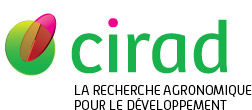Diarra Maryam, Fall Moussa, Fall Assane Gueye, Diop Aliou, Seck Momar Talla, Garros Claire, Balenghien Thomas, Allene Xavier, Rakotoarivony Ignace, Lancelot Renaud, Mall Iba, Bakhoum Mame Thierno, Dosum Ange Michel, Ndao Massouka, Bouyer Jérémy, Guis Hélène. 2014. Seasonal dynamics of Culicoides (Diptera: Ceratopogonidae) biting midges, potential vectors of African horse sickness and bluetongue viruses in the Niayes area of Senegal. Parasites and Vectors, 7 (147), 11 p.

|
Version publiée
- Anglais
Utilisation soumise à autorisation de l'auteur ou du Cirad. document_573134.pdf Télécharger (2MB) | Prévisualisation |
Quartile : Q1, Sujet : PARASITOLOGY
Résumé : Background The African horse sickness epizootic in Senegal in 2007 caused considerable mortality in the equine population and hence major economic losses. The vectors involved in the transmission of this arbovirus have never been studied specifically in Senegal. This first study of the spatial and temporal dynamics of the Culicoides (Diptera: Ceratopogonidae) species, potential vectors of African horse sickness in Senegal, was conducted at five sites (Mbao, Parc Hann, Niague, Pout and Thies) in the Niayes area, which was affected by the outbreak. Methods Two Onderstepoort light traps were used at each site for three nights of consecutive collection per month over one year to measure the apparent abundance of the Culicoides midges. Results In total, 224,665 specimens belonging to at least 24 different species (distributed among 11 groups of species) of the Culicoides genus were captured in 354 individual collections. Culicoides oxystoma, Culicoides kingi, Culicoides imicola, Culicoides enderleini and Culicoides nivosus were the most abundant and most frequent species at the collection sites. Peaks of abundance coincide with the rainy season in September and October. Conclusions In addition to C. imicola, considered a major vector for the African horse sickness virus, C. oxystoma may also be involved in the transmission of this virus in Senegal given its abundance in the vicinity of horses and its suspected competence for other arboviruses including bluetongue virus. This study depicted a site-dependent spatial variability in the dynamics of the populations of the five major species in relation to the eco-climatic conditions at each site.
Mots-clés Agrovoc : Culicoides, vecteur de maladie, dynamique des populations, distribution spatiale, transmission des maladies, variation saisonnière, facteur climatique, épidémiologie, Equidae, virus bluetongue, virus peste équine africaine, fièvre catarrhale ovine, peste équine africaine, Orbivirus, piège lumineux, Culicoides oxystoma
Mots-clés géographiques Agrovoc : Sénégal
Mots-clés complémentaires : Culicoides imicola
Classification Agris : L72 - Organismes nuisibles des animaux
L73 - Maladies des animaux
P40 - Météorologie et climatologie
Champ stratégique Cirad : Axe 4 (2014-2018) - Santé des animaux et des plantes
Auteurs et affiliations
- Diarra Maryam, ISRA (SEN)
- Fall Moussa, ISRA (SEN)
- Fall Assane Gueye, ISRA (SEN)
- Diop Aliou, Université Gaston Berger (SEN)
- Seck Momar Talla, ISRA (SEN)
-
Garros Claire, CIRAD-BIOS-UMR CMAEE (FRA)
 ORCID: 0000-0003-4378-5031
ORCID: 0000-0003-4378-5031
- Balenghien Thomas, CIRAD-BIOS-UMR CMAEE (FRA)
- Allene Xavier, CIRAD-BIOS-UMR CMAEE (FRA)
- Rakotoarivony Ignace, CIRAD-BIOS-UMR CMAEE (FRA)
- Lancelot Renaud, CIRAD-BIOS-UMR CMAEE (FRA)
- Mall Iba, ISRA (SEN)
- Bakhoum Mame Thierno, ISRA (SEN)
- Dosum Ange Michel, ISRA (SEN)
- Ndao Massouka, ISRA (SEN)
-
Bouyer Jérémy, CIRAD-BIOS-UMR CMAEE (SEN)
 ORCID: 0000-0002-1913-416X
ORCID: 0000-0002-1913-416X
- Guis Hélène, CIRAD-BIOS-UMR CMAEE (FRA)
Source : Cirad - Agritrop (https://agritrop.cirad.fr/573134/)
[ Page générée et mise en cache le 2024-04-02 ]




